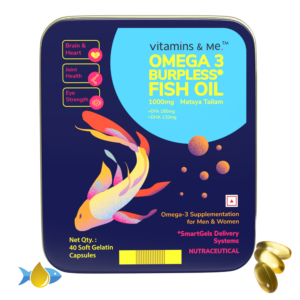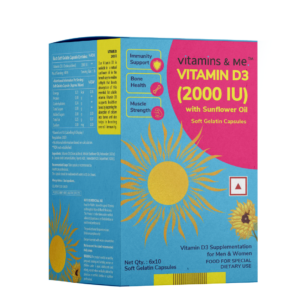VITAMIN C, AMLA EXTRACT 1000mg & ZINC 90 Veg Tablets
![]()
- Boost Your Immune System: Our Vitamin C supplement is infused with 100% natural Vitamin C from Amla extract, which is known to improve immune function and help fight off illnesses and infections.
- Antioxidant Powerhouse: Our supplement contains Amla, Vitamin C and Zinc which are potent antioxidants that protect your body from free radicals and oxidative stress.
- Healthy Skin: Bliss Our supplement with Amla and Vitamin C can help improve skin health by promoting collagen synthesis, reducing fine lines, and improving skin elasticity.
- Natural and Safe: These Amla 1000 mg Vitamin C supplements are made with natural ingredients and are free from harmful chemicals, making them safe to consume daily.
- High Bioavailability: This supplement has been scientifically created and formulated to ensure maximum effectiveness and optimal bio-availability and absorption rates.
Net Qty: 90 Tablets
MRP ₹: 799, USP ₹ Per Tablet: 08.87
Country of Origin: INDIA
Out of stock
Offers
₹799.00 ₹249.00
Out of stock
SKU
1000
Category Letter Vitamins






FSSAI APPROVED

USFDA REGISTERED

GMP CERTIFIED

ISO CERTIFIED

MAKE IN INDIA
Active Ingredients

Amla Extract
Amla Extract 1000 mg

Vitamin C
Vitamin C 40 mg

Zinc
Zinc 10 mg
SCIENTIFIC EVIDENCE
AMLA: THE AYURVEDIC WONDER
VITAMIN C DEFICIENCY IN INDIAN POPULATION
SUPPORTS IMMUNITY
AMLA: THE AYURVEDIC WONDER
Medicinal plants have been used for centuries to promote a disease-free healthy life. Phyllanthus emblica Linn. (also known as Indian gooseberry or amla) is an important medicinal plant used in traditional health care systems like Ayurveda and Unani. The plant is highly nutritious and contains various compounds like phenolic compounds, tannins, and vitamins, making it an important source of dietary supplements. Several parts of the plant have been used to treat various ailments, including diarrhea, jaundice, and inflammation. Additionally, the plant exhibits antidiabetic, hypolipidemic (4), antibacterial, antioxidant, and hepatoprotective properties (1). Numerous phytochemicals have been isolated from the plant, and its ethnomedical and pharmacological potentials have been extensively studied (2). Further research is required to identify and evaluate the chemical constituents for nutritional and therapeutic potential. In a randomized, double-blinded, placebo-controlled study, ingestion of lingonberry and amla fruit extract (LAE) showed significant improvements in skin elasticity, thickness, stratum corneum water content, and degree of wrinkles, indicating that LAE may be considered a candidate anti-aging agent for preventing skin weakening (3).
1. Krishnaveni, Mani, and Sankaran Mirunalini. “Therapeutic Potential of Phyllanthus Emblica (Amla): The Ayurvedic Wonder.” Journal of Basic and Clinical Physiology and Pharmacology 21, no. 1 (2010): 93–105. https://doi.org/10.1515/jbcpp.2010.21.1.93.
2. Variya, Bhavesh C., Anita K. Bakrania, and Snehal S. Patel. “Emblica Officinalis (Amla): A Review for Its Phytochemistry, Ethnomedicinal Uses and Medicinal Potentials with Respect to Molecular Mechanisms.” Pharmacological Research 111 (September 2016): 180–200. https://doi.org/10.1016/j.phrs.2016.06.013.
3. Uchiyama, Taro, Makoto Tsunenaga, Miho Miyanaga, Osamu Ueda, and Masashi Ogo. “Oral Intake of Lingonberry and Amla Fruit Extract Improves Skin Conditions in Healthy Female Subjects: A Randomized, Double-Blind, Placebo-Controlled Clinical Trial.” Biotechnology and Applied Biochemistry 66, no. 5 (September 2019): 870–79. https://doi.org/10.1002/bab.1800.
4. Upadya, Haridas, S. Prabhu, Aravinda Prasad, Deepa Subramanian, Swati Gupta, and Ajay Goel. “A Randomized, Double Blind, Placebo Controlled, Multicenter Clinical Trial to Assess the Efficacy and Safety of Emblica Officinalis Extract in Patients with Dyslipidemia.” BMC Complementary and Alternative Medicine 19, no. 1 (January 22, 2019): 27. https://doi.org/10.1186/s12906-019-2430-y.
1. Krishnaveni, Mani, and Sankaran Mirunalini. “Therapeutic Potential of Phyllanthus Emblica (Amla): The Ayurvedic Wonder.” Journal of Basic and Clinical Physiology and Pharmacology 21, no. 1 (2010): 93–105. https://doi.org/10.1515/jbcpp.2010.21.1.93.
2. Variya, Bhavesh C., Anita K. Bakrania, and Snehal S. Patel. “Emblica Officinalis (Amla): A Review for Its Phytochemistry, Ethnomedicinal Uses and Medicinal Potentials with Respect to Molecular Mechanisms.” Pharmacological Research 111 (September 2016): 180–200. https://doi.org/10.1016/j.phrs.2016.06.013.
3. Uchiyama, Taro, Makoto Tsunenaga, Miho Miyanaga, Osamu Ueda, and Masashi Ogo. “Oral Intake of Lingonberry and Amla Fruit Extract Improves Skin Conditions in Healthy Female Subjects: A Randomized, Double-Blind, Placebo-Controlled Clinical Trial.” Biotechnology and Applied Biochemistry 66, no. 5 (September 2019): 870–79. https://doi.org/10.1002/bab.1800.
4. Upadya, Haridas, S. Prabhu, Aravinda Prasad, Deepa Subramanian, Swati Gupta, and Ajay Goel. “A Randomized, Double Blind, Placebo Controlled, Multicenter Clinical Trial to Assess the Efficacy and Safety of Emblica Officinalis Extract in Patients with Dyslipidemia.” BMC Complementary and Alternative Medicine 19, no. 1 (January 22, 2019): 27. https://doi.org/10.1186/s12906-019-2430-y.
VITAMIN C DEFICIENCY IN INDIAN POPULATION
A population-based cross sectional survey in two areas of north and south India were investigated for the prevalence of vitamin C deficiency in people aged more than 60. The age, sex and season standardized prevalence of vitamin C deficiency was 73.9% in 2668 people in north India and 45.7% in 2970 from south India (1). This indicated the poor nutrition and lower dietary intakes of vitamin C in communities of Indian population.
A cross-sectional study on adults from Western India was done to examine interrelationships between (a) dietary habits, (b) socioeconomic and (c) environmental factors, and their impact on plasma ascorbic acid (2-3). Subnormal status of vitamin C was observed and the study emphasizes the need to increase consumption of fruit, Green leafy vegetables and milk products, and also better education and environment.
References
1. Ravindran, R.D., Vashist, P., Gupta, S.K., Young, I.S., Maraini, G., Camparini, M., Jayanthi, R., John, N., Fitzpatrick, K.E., Chakravarthy, U., Ravilla, T.D., Fletcher, A.E., 2011. Prevalence and risk factors for vitamin C deficiency in north and south India: a two centre population based study in people aged 60 years and over. PLoS ONE 6, e28588. https://doi.org/10.1371/journal.pone.0028588
2. Chiplonkar, S.A., Agte, V.V., Mengale, S.S., Tarwadi, K.V., 2002. Are lifestyle factors good predictors of retinol and vitamin C deficiency in apparently healthy adults? Eur J Clin Nutr 56, 96–104. https://doi.org/10.1038/sj.ejcn.1601291 3. Chatterjee, I.B., 2009. The history of vitamin C research in India. J. Biosci. 34, 185–194. https://doi.org/10.1007/s12038-009-0021-7 4. Vitamin C Deficiency | National Health Portal of India. Available from: http://www.nutrition-atlas.nin.res.in/nutritionatlas/vitc.php
References
1. Ravindran, R.D., Vashist, P., Gupta, S.K., Young, I.S., Maraini, G., Camparini, M., Jayanthi, R., John, N., Fitzpatrick, K.E., Chakravarthy, U., Ravilla, T.D., Fletcher, A.E., 2011. Prevalence and risk factors for vitamin C deficiency in north and south India: a two centre population based study in people aged 60 years and over. PLoS ONE 6, e28588. https://doi.org/10.1371/journal.pone.0028588
2. Chiplonkar, S.A., Agte, V.V., Mengale, S.S., Tarwadi, K.V., 2002. Are lifestyle factors good predictors of retinol and vitamin C deficiency in apparently healthy adults? Eur J Clin Nutr 56, 96–104. https://doi.org/10.1038/sj.ejcn.1601291 3. Chatterjee, I.B., 2009. The history of vitamin C research in India. J. Biosci. 34, 185–194. https://doi.org/10.1007/s12038-009-0021-7 4. Vitamin C Deficiency | National Health Portal of India. Available from: http://www.nutrition-atlas.nin.res.in/nutritionatlas/vitc.php
SUPPORTS IMMUNITY
Scientific evidence suggests that vitamin C supplementation in adults and children with a common cold can significantly reduce its duration and severity and relieve cold symptoms (1-2). Furthermore, supplementation with vitamin C appears to be able to both prevent and treat respiratory and systemic infections.
Three controlled trials found that vitamin C prevented pneumonia (3). Two controlled trials found a treatment benefit of vitamin C for pneumonia patients.
References
1. Gombart, A.F., Pierre, A., Maggini, S., 2020. A Review of Micronutrients and the Immune System–Working in Harmony to Reduce the Risk of Infection. Nutrients 12. https://doi.org/10.3390/nu12010236
2. Carr, A.C., Maggini, S., 2017. Vitamin C and Immune Function. Nutrients 9. https://doi.org/10.3390/nu9111211
3. Ran, L., Zhao, W., Wang, J., Wang, H., Zhao, Y., Tseng, Y., Bu, H., 2018. Extra Dose of Vitamin C Based on a Daily Supplementation Shortens the Common Cold: A Meta-Analysis of 9 Randomized Controlled Trials. Biomed Res Int 2018, 1837634. https://doi.org/10.1155/2018/1837634
4. Hemilä, H., 2017. Vitamin C and Infections. Nutrients 9. https://doi.org/10.3390/nu9040339
References
1. Gombart, A.F., Pierre, A., Maggini, S., 2020. A Review of Micronutrients and the Immune System–Working in Harmony to Reduce the Risk of Infection. Nutrients 12. https://doi.org/10.3390/nu12010236
2. Carr, A.C., Maggini, S., 2017. Vitamin C and Immune Function. Nutrients 9. https://doi.org/10.3390/nu9111211
3. Ran, L., Zhao, W., Wang, J., Wang, H., Zhao, Y., Tseng, Y., Bu, H., 2018. Extra Dose of Vitamin C Based on a Daily Supplementation Shortens the Common Cold: A Meta-Analysis of 9 Randomized Controlled Trials. Biomed Res Int 2018, 1837634. https://doi.org/10.1155/2018/1837634
4. Hemilä, H., 2017. Vitamin C and Infections. Nutrients 9. https://doi.org/10.3390/nu9040339

NON-GMO

GLUTEN FREE

HALAL

NO EGG

DAIRY FREE
Important to know
Vitamin C deficiency can lead to a range of symptoms that can affect your health and well-being. These include weakened immunity, dry and damaged skin, severe fatigue, painful joints, and bleeding gums and tooth.
For adults: Take one tablet in a day or as recommended by Healthcare professional

Trusted by over 10000+ Clients worldwide since 2020
4.6
4.6/5
Formulated by Pharmacists
Related products
-
Sale!
 Out of stock
Letter Vitamins
Out of stock
Letter VitaminsOMEGA 3 BURPLESS FISH OIL 1000 MG with 180 MG EPA & 120 MG DHA 40 Softgels
₹699.00₹299.00 -
Sale!
 Out of stock
Out of stock
-
Sale!
 Out of stock
Letter Vitamins
Out of stock
Letter VitaminsCALCIUM with MAGNEISUM, ZINC, VITAMIN D3 & CISSUS QUADRANGULARIS, 60 Tablets
₹599.00₹149.00








